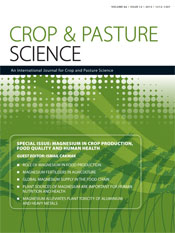
Crop and Pasture Science
Volume 66 Number 12 2015
Magnesium in Crop Production, Food Quality and Human Health
CP15094Role of magnesium in food production: an overview
The focus of this paper is on the agricultural production systems, mainly related to sustainability, fertilisers efficiency use and food security, with emphasis on soils of tropical regions. Magnesium in soils and plants, as well as in relation to other nutrients and in broad sense to other agricultural production factors, is especially covered. The subject is considered in terms of plant and animal health, nutrient management and the need of future research on magnesium.
CP15104Role of magnesium fertilisers in agriculture: plant–soil continuum
In this review, we summarise factors contributing to plant availability of magnesium (Mg) in soils, the role of Mg in plant physiological processes related to yield formation and abiotic stress tolerance. The role of Mg and the specific requirements for Mg supply were presented for different crops in relation to these facts. Finally an experimental analysis describing the leaching potential and nutrient availability of different Mg-fertilisers in soil is presented.
CP15104 Abstract | CP15104 Full Text | CP15104PDF (960 KB) Open Access Article
CP15101Magnesium balance in four permanent manurial experiments under rainfed agro-ecosystems of India
Magnesium nutrition is not considered in nutrient management in many countries, particularly in Indian rainfed systems, and this may lead to Mg depletion and encourage important productivity constraints. This work emphasised exchangeable Mg status and balance in different rainfed soils and production systems; therefore, the results can be interpreted in the light of similar crops and edaphoclimatic conditions elsewhere in world.
CP14228Phylogenetic effects on shoot magnesium concentration
Knowledge of the concentrations of magnesium (Mg) in crops and pastures can help in formulation of appropriate human and animal diets. Ancient evolutionary processes have resulted in large differences in shoot Mg concentrations between plant species. This paper reports that the peculiarly high shoot Mg concentrations found in species of the Caryophyllales order, such as the amaranths, buckwheats and beets, evolved in an ancient ancestor of all the Caryophyllales families.
CP15108Natural genetic variation of Arabidopsis thaliana root morphological response to magnesium supply
Magnesium (Mg) deficiency compromises crop production in many agricultural areas, but little is known about how the root organ adapts to low availability of Mg in soil. Making use of the wide geographical distribution of the genetic model species Arabidopsis thaliana, we found different impact on lateral root growth of natural accessions in response to low Mg supply under in vitro culture. Exploitation of that variation may help to understand adaptive evolutionary responses to Mg deficiency and to breed for crops better at capturing nutrients in soil.
Recent findings suggest that the estimated average requirement and recommended dietary allowance (RDA) for magnesium (Mg) need modification. Carefully controlled metabolic unit studies suggest that an RDA of ~250 mg day–1 is appropriate for healthy 70-kg adults, an intake many do not achieve. The Mg content of foods of plant origin can be a significant determinant of whether a diet provides the Mg RDA.
CP15085Edible plant tissue and soil calcium:magnesium ratios: data too sparse to assess implications for human health
Dietary Ca:Mg has implications for human health. We found too little data on edible plant tissues to discern from agricultural literature if soil Ca:Mg might impact human dietary Ca:Mg. Nutritional measurement in edible tissues are necessary to assess any impact soil Ca:Mg might have on human health.
CP15096Global magnesium supply in the food chain
CP15090Across-trophic variation of potassium, calcium and magnesium stoichiometric traits in a parasitism food chain across temperate and subtropical biomes
The concentration of magnesium in soils, plants and herbivore insects significantly varied along climate variables. This also resulted in a significant variation in the ratios of magnesium with potassium and calcium in the two trophics. The results greatly help us understand the effects of climate change on these metal elements in ecosystems.
CP15284Magnesium alleviates plant toxicity of aluminium and heavy metals
This review critically appraises the available literature on the role of magnesium in alleviating toxicity of aluminium and other metals. Magnesium competes with metal ions for binding to the negative charges in the cell wall and the plasma membrane and is an activator of H+-transporting pumps and enzymes involved in biosynthesis of organic ligands.



